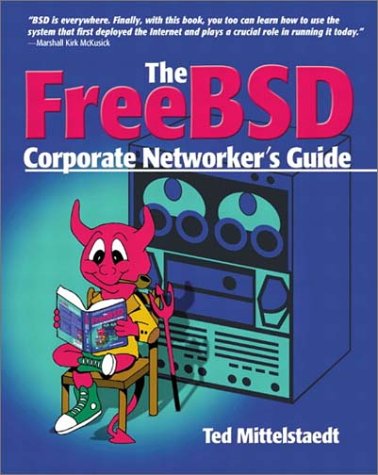The FreeBSD Corporate Networker's Guide is written for the beginning FreeBSD administrator who wants to take advantage of the power and cost savings afforded by use of this operating system on their organization's production network. FreeBSD is a UNIX-like operating system that takes its name from the Berkeley Software Distribution group. FreeBSD is a direct descendent of the original BSD UNIX code that the Computing Science Research Group of the University of California, Berkeley, released. That code was used as a base for many other commercial UNIX systems, such as early HP/UX and Sun's SunOS 4.1.X
In keeping with the spirit of freely available Open Source software, this book has operating with the Microsoft (MS) operating system and Microsoft networking as a primary goal. Use of FreeBSD to solve problems in a corporate network environment is emphasized.
Basing an organizational production network on standards-based methods and protocols such as TCP/IP, is important as it permits you to mix and match FreeBSD and Windows servers and clients as you see fit. Using FreeBSD and Windows on the same network is an excellent way to do this.
The first section of this book, Chapters 1 through 3, covers preinstallation and installation of FreeBSD. Chapters 4 through 9 are intended to be taken piecemeal. Do you need a FreeBSD router to connect to the Internet? If so, skip to Chapter 5. Do you need a FreeBSD mailserver? If so, skip to Chapter 9. Although there is some order, in that later topics do build on some material introduced in earlier chapters, the main idea is to concentrate first on the sections for which you have an immediate need. Chapter 10, Advocacy, contains material that polarized the reviewers. Some loved it, some hated it; nobody lacked an opinion about it. This chapter presents all the reasons to use FreeBSD instead of Windows, and it includes some background information about FreeBSD.
The book includes a CD of the Release version of FreeBSD 4.2, this is the same CD as used in CD#1 of the 4-CD set of FreeBSD 4.2 published by BSD Inc./Walnut Creek. There is also a companion website that the Author maintains specifically for this book.
Commentaires de l'éditeur
From the Back Cover "FreeBSD has been the secret weapon of serious network administrators for many years now and this book should provide a welcome introduction to those who have yet to discover it for themselves."
--Jordan Hubbard, Co-founder, The FreeBSD Project
FreeBSD is the engine that runs on some of today's largest Internet servers, such as Yahoo!, Microsoft's Hotmail, and Walnut Creek. The power, flexibility, and cost effectiveness of FreeBSD make it the preferred server platform of many corporate networks, including networks in which the Windows OS predominates.
The FreeBSD Corporate Networker's Guide provides practical instructions for using FreeBSD to serve a largely Windows corporate network. Written for network managers and administrators, this book shows how FreeBSD and Windows can coexist and interoperate on the same network with few problems, and it reveals how to maximize FreeBSD's many advantages for optimal network performance.
The book contains an overview of FreeBSD serving a Windows network and a step-by-step FreeBSD installation guide. Key network server topics--system administration, Internet connectivity, Web servers, fileserving, printserving, and e-mail--are addressed in depth. You will read about specific topics, such as:
- The FreeBSD user interface versus the Windows user interface
- Dual booting of Windows NT and FreeBSD
- DNS, DHCP, and TCP/IP on the corporate LAN
- FreeBSD installation phases, X installation, PPP installation, and disk configuration
- FreeBSD environment setup, backups, logs, and other system administrative tasks
- Migrating password files, UNIX equivalents of DOS commands, and some Windows-to-UNIX issues
- Internet security, proxy serving, and FreeBSD routers
- The Apache Web server, Windows Web publishing tools, and the vi HTML tool
- Fileserving with Samba-SMB and NetBIOS protocols, browsing, and passwords Setting up LPR on Windows clients and FreeBSD,
- Managing the UNIX printserver queue Installing Sendmail on FreeBSD,
- Connecting a mailserver to the Internet.
In addition, The FreeBSD Corporate Networker's Guide highlights FreeBSD's many technical advantages, the history and rationale behind its development, and its relationship to Linux.The CD that comes with this book contains the base FreeBSD 4.2 operating system for the Intel i386 platform, including installer and bootable CD-ROM support. The disk also contains XFree86 3.3.6 for FreeBSD, and several hundred of the most popular third-party packages for FreeBSD.
À propos de l'auteur
Ted Mittelstaedt is the Network Operations Center Director at Internet Partners, Inc., in Portland, Oregon. Previously, he was the IS Manager at Portland Software, Senior Developer at Computers Plus, and Senior Systems Administrator at Symantec. He has been using FreeBSD commercially since its initial release. A well-known expert, Mittelstaedt writes networking articles for Computer Bits magazine, wrote most of the FAQs for sendmail, and frequently contributes to the Usenet newsgroup comp.unix.bsd.freebsd.misc.









